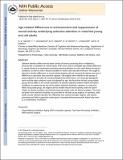| dc.contributor.author | Haring, A.E. | |
| dc.contributor.author | Zhuravleva, T.Y. | |
| dc.contributor.author | Alperin, B.R. | |
| dc.contributor.author | Rentz, Dorene May | |
| dc.contributor.author | Holcomb, P.J. | |
| dc.contributor.author | Daffner, Kirk R. | |
| dc.date.accessioned | 2017-04-26T16:32:52Z | |
| dc.date.issued | 2013 | |
| dc.identifier | Quick submit: 2014-06-05T15:14:43-04:00 | |
| dc.identifier.citation | Haring, A.E., T.Y. Zhuravleva, B.R. Alperin, D.M. Rentz, P.J. Holcomb, and K.R. Daffner. 2013. “Age-Related Differences in Enhancement and Suppression of Neural Activity Underlying Selective Attention in Matched Young and Old Adults.” Brain Research 1499: 69–79. | en_US |
| dc.identifier.issn | 0006-8993 | en_US |
| dc.identifier.uri | http://nrs.harvard.edu/urn-3:HUL.InstRepos:32521793 | |
| dc.description.abstract | Selective attention reflects the top-down control of sensory processing that is mediated by enhancement or inhibition of neural activity. ERPs were used to investigate age-related differences in neural activity in an experiment examining selective attention to color under Attend and Ignore conditions, as well as under a Neutral condition in which color was task-irrelevant. We sought to determine whether differences in neural activity between old and young adult subjects were due to differences in age rather than executive capacity. Old subjects were matched to two groups of young subjects on the basis of neuropsychological test performance: one using age-appropriate norms and the other using test scores not adjusted for age. We found that old and young subject groups did not differ in the overall modulation of selective attention between Attend and Ignore conditions, as indexed by the size of the anterior Selection Positivity. However, in contrast to either young adult group, old subjects did not exhibit reduced neural activity under the Ignore relative to Neutral condition, but showed enhanced activity under the Attend condition. The onset and peak of the Selection Positivity occurred later for old than young subjects. In summary, older adults execute selective attention less efficiently than matched younger subjects, with slowed processing and failed suppression under Ignore. Increased enhancement under Attend may serve as a compensatory mechanism. | en_US |
| dc.language.iso | en_US | en_US |
| dc.publisher | Elsevier BV | en_US |
| dc.relation.isversionof | 10.1016/j.brainres.2013.01.003 | en_US |
| dc.relation.hasversion | https://www.ncbi.nlm.nih.gov/pmc/articles/PMC3570693/ | en_US |
| dash.license | LAA | |
| dc.subject | Visual selective attention | en_US |
| dc.subject | Aging | en_US |
| dc.subject | ERPs | en_US |
| dc.subject | Executive capacity | en_US |
| dc.subject | Top-down processing | en_US |
| dc.subject | Inhibition | en_US |
| dc.subject | Well-matched subjects | en_US |
| dc.title | Age-related differences in enhancement and suppression of neural activity underlying selective attention in matched young and old adults | en_US |
| dc.type | Journal Article | en_US |
| dc.date.updated | 2014-06-05T19:14:43Z | |
| dc.description.version | Accepted Manuscript | en_US |
| dc.rights.holder | Haring, A. E. Zhuravleva, T. Y. Alperin, B. R. Rentz, D. M. Holcomb, P. J. Daffner, K. R. | |
| dc.relation.journal | Brain Research | en_US |
| dash.depositing.author | Daffner, Kirk R. | |
| dc.date.available | 2017-04-26T16:32:52Z | |
| dc.identifier.doi | 10.1016/j.brainres.2013.01.003 | * |
| dash.contributor.affiliated | Daffner, Kirk | |
| dash.contributor.affiliated | Rentz, Dorene | |


